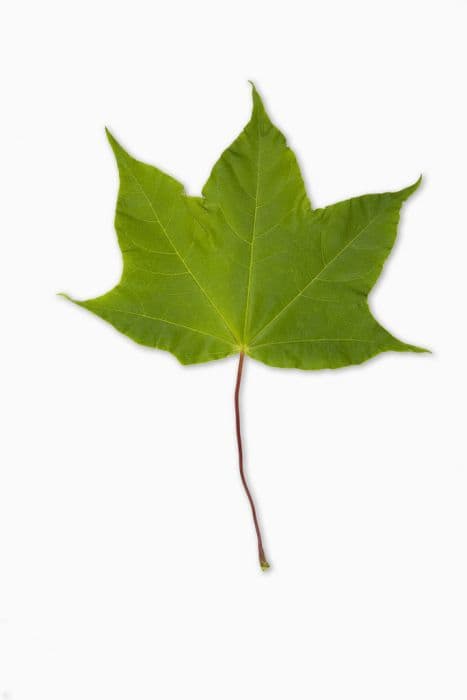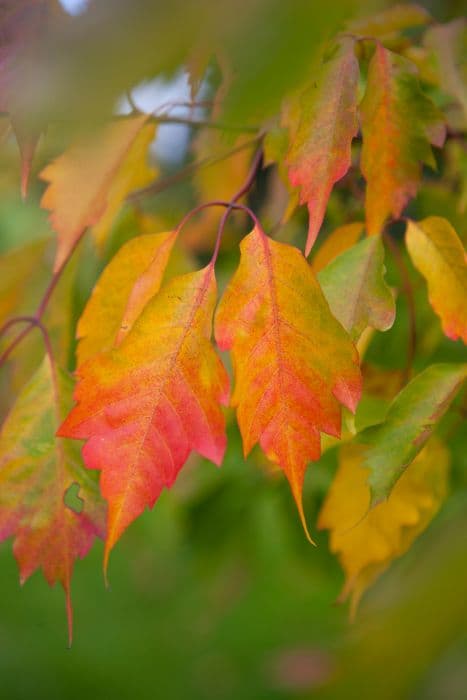Serpentine Maple Acer 'Serpentine'

ABOUT
The Acer 'Serpentine' is known more commonly as a variant of the Serpentine maple. It is appreciated for its ornamental features, which include an intricate branching habit that can be appreciated especially during the winter months when the leaves have fallen. The leaves of this tree are its most striking characteristic. They're typically palmate, resembling the palm of a hand with outstretched fingers, with several lobes that give the leaves a deeply dissected appearance. The foliage goes through a pleasant transition of colors with the seasons; the leaves can emerge in a bright green or sometimes with a reddish tint in the spring, change to a lush green in the summer, and then transform into shades of yellow, orange, or red in the autumn. The bark of the tree is often smooth and may have a greenish to grayish-brown color, sometimes featuring vertical striations that add to its ornamental quality. The Acer 'Serpentine' can produce flowers that are generally small and not particular conspicuous, typically blooming in spring. These may give way to winged seeds, called samaras, which are distinctive to maples. These seeds can appear in pairs and helicopter away from the tree when they detach. Overall, the Acer 'Serpentine' has a graceful silhouette with branches that may weep or curve in a serpentine fashion, which contributes to the aesthetic value and the name of this plant variety.
About this plant
 Names
NamesFamily
Sapindaceae
Synonyms
Serpentine Maple
Common names
Acer 'Serpentine'.
 Toxicity
ToxicityTo humans
The Acer 'Serpentine' is commonly known as a variety of Snakebark Maple. Generally, maples are not considered highly toxic to humans. However, some people may experience minor symptoms such as dermatitis from handling the leaves or sap due to individual sensitivities. Ingestion is not typically associated with severe toxicity, but as with many plants not intended for consumption, it is advisable to avoid ingesting parts of the plant as it could cause gastrointestinal discomfort or other mild symptoms in sensitive individuals.
To pets
The Snakebark Maple is not known to be highly toxic to pets either. However, as with humans, individual animals might have sensitivities that could result in minor symptoms. If a pet ingests parts of this plant, they might experience some gastrointestinal upset, such as vomiting or diarrhea. If you suspect your pet has ingested a considerable amount of any plant, it is always best to consult with a veterinarian.
 Characteristics
CharacteristicsLife cycle
Perennials
Foliage type
Deciduous
Color of leaves
Varies
Height
20 feet (6 meters)
Spread
15 feet (4.5 meters)
Plant type
Tree
Hardiness zones
5
Native area
Asia
Benefits
 General Benefits
General Benefits- Ornamental Appeal: Features attractive serpentine-like growth that adds visual interest to gardens and landscapes.
- Year-Round Interest: Offers vibrant autumn colors and unique winter branch patterns.
- Shade Provision: Can provide shade in gardens and outdoor living spaces due to its size and foliage.
- Habitat Support: Serves as a habitat and food source for local wildlife, such as birds and insects.
- Low Maintenance: Typically requires minimal care once established, making it suitable for many gardeners.
- Drought Tolerance: Able to withstand periods of dry conditions after it is well established.
- Soil Adaptability: Can thrive in a variety of soil types, as long as they are well-draining.
- Cold Hardy: Resistant to cold weather and can survive in cooler climates.
- Urban Tolerant: Capable of growing in urban conditions where air pollution and confined space might be issues.
 Medical Properties
Medical PropertiesThis plant is not used for medical purposes.
 Air-purifying Qualities
Air-purifying QualitiesThis plant is not specifically known for air purifying qualities.
 Other Uses
Other Uses- Acer 'Serpentine', commonly known as the Serpentine Maple, can be utilized in bonsai cultivation for its unique twisted growth habit and attractive foliage.
- The wood of the Serpentine Maple is sometimes used in woodworking projects, particularly for decorative veneers or small crafted items where its distinctive grain can be shown off.
- The leaves of the Serpentine Maple can serve as a natural dye, providing shades of green or brown when used in traditional fabric dying processes.
- This maple variety is used in landscape design for its sculptural qualities, making it a focal point in artistic garden compositions.
- Serpentine Maple trees can be planted to provide privacy screens or windbreaks in residential and public gardens due to their dense foliage.
- Dried branches of the Serpentine Maple can be employed in floral arrangements or craft projects for their interesting form and texture.
- The tree’s canopy can offer a unique patterned shade, creating dappled light effects on the ground beneath, which is appealing in outdoor sitting areas and patios.
- Leaves from the Serpentine Maple can contribute to compost heaps as a source of nutrients and organic matter to improve soil health.
- During autumn, the fallen leaves of this maple can be used in decorative displays or crafts thanks to their vibrant seasonal colors.
- The tree can act as a natural sound barrier, reducing noise pollution in gardens and landscapes close to busy streets or highways.
Interesting Facts
 Feng Shui
Feng ShuiThe Snakebark Maple is not used in Feng Shui practice.
 Zodiac Sign Compitability
Zodiac Sign CompitabilityThe Snakebark Maple is not used in astrology practice.
 Plant Symbolism
Plant Symbolism- Strength: As a member of the maple family, the Acer 'Serpentine', commonly known as the Serpentine Maple, often symbolizes strength due to its hardwood and resilient nature.
- Longevity: Maples, in general, are known to live for a long time, which makes the Serpentine Maple represent long life and endurance.
- Adaptability: Given its growth pattern and ability to thrive in various conditions, this plant can symbolize the ability of the person to adapt to different life circumstances.
- Balance: The intricate and balanced structure of its branches and leaves can represent the idea of living a balanced life or seeking harmony in one's endeavors.
 Water
WaterSnakebark Maple requires consistent moisture, so it should be watered deeply once a week, providing about 2 inches of water each time. During hot or dry spells, increase watering to twice a week. The water should be applied directly to the base of the tree, avoiding wetting the foliage to prevent fungal diseases. Reduce watering in the fall to help the tree harden off for winter. It is important not to overwater, as this can lead to root rot.
 Light
LightSnakebark Maple thrives in partial shade to full sun. It prefers a spot that receives morning sunlight and is protected from the intense heat of the afternoon sun. The ideal location would provide some shelter from strong winds, as this could damage the leaves and branches.
 Temperature
TemperatureSnakebark Maple can tolerate a temperature range between -20°F to 80°F but prefers consistent temperatures between 60°F to 75°F. Prolonged exposure to temperatures below -20°F can damage the plant, while temperatures above 80°F may stress it, especially if humidity is low. It is well-suited to temperate climates with four distinct seasons.
 Pruning
PruningPrune Snakebark Maple to maintain its shape and health, removing any dead, diseased, or crossing branches. This is best done in late winter or early spring while the tree is dormant. Light pruning can be done annually, but major pruning should be spaced out every few years to prevent stress on the tree.
 Cleaning
CleaningNot needed
 Soil
SoilThe Serpentine Green Japanese Maple will thrive best in well-draining, acidic to neutral soil with a pH range of 5.5 to 7. A mixture of loam, peat, and pine bark is ideal, ensuring good aeration and moisture retention.
 Repotting
RepottingThe Serpentine Green Japanese Maple should be repotted every two to three years or when it appears to be outgrowing its pot, to ensure that it continues to have enough space for root growth.
 Humidity & Misting
Humidity & MistingThe Serpentine Green Japanese Maple prefers moderate humidity levels but can tolerate some variation; consistent levels between 40-60% are ideal for its health.
 Suitable locations
Suitable locationsIndoor
Ensure bright, indirect light, and avoid dry heat sources.
Outdoor
Plant in moist, well-draining soil; partial shade.
Hardiness zone
5-7 USDA.
 Life cycle
Life cycleThe life of a 'Serpentine' Maple (Acer 'Serpentine') begins as a seed, which requires stratification to break dormancy before it germinates in spring. Upon germination, the seedling starts to develop its root system and grows its first set of true leaves, entering the juvenile stage characterized by rapid growth. As it matures, the 'Serpentine' Maple enters the vegetative stage, developing its distinct serpentine trunk and dense foliage over several years. When the tree reaches maturity after several years, it begins the reproductive stage, flowering in early spring; the flowers are followed by the development of winged samaras that disperse with the wind. After releasing its seeds, the tree goes into a period of dormancy during the colder months, during which it conserves energy and sustains itself with stored nutrients. This cycle of growth, reproduction, and dormancy repeats annually, with the tree potentially living for decades and growing up to a medium size depending on its environmental conditions.
 Propogation
PropogationPropogation time
Spring-Early Summer
The most popular method of propagation for the 'Serpentine' Red Maple is through softwood cuttings taken in late spring to early summer. The cuttings should be about 4–6 inches (10–15 cm) long, with the leaves removed from the lower half of the cutting. It's essential to use a rooting hormone to enhance rooting success, and plant the cuttings in a well-draining propagation medium like a mixture of peat and perlite. The environment should be kept humid, often achieved through a plastic cover to retain moisture. Cuttings typically root within a few weeks, after which they can be gradually acclimated to less humid conditions before transplanting.









